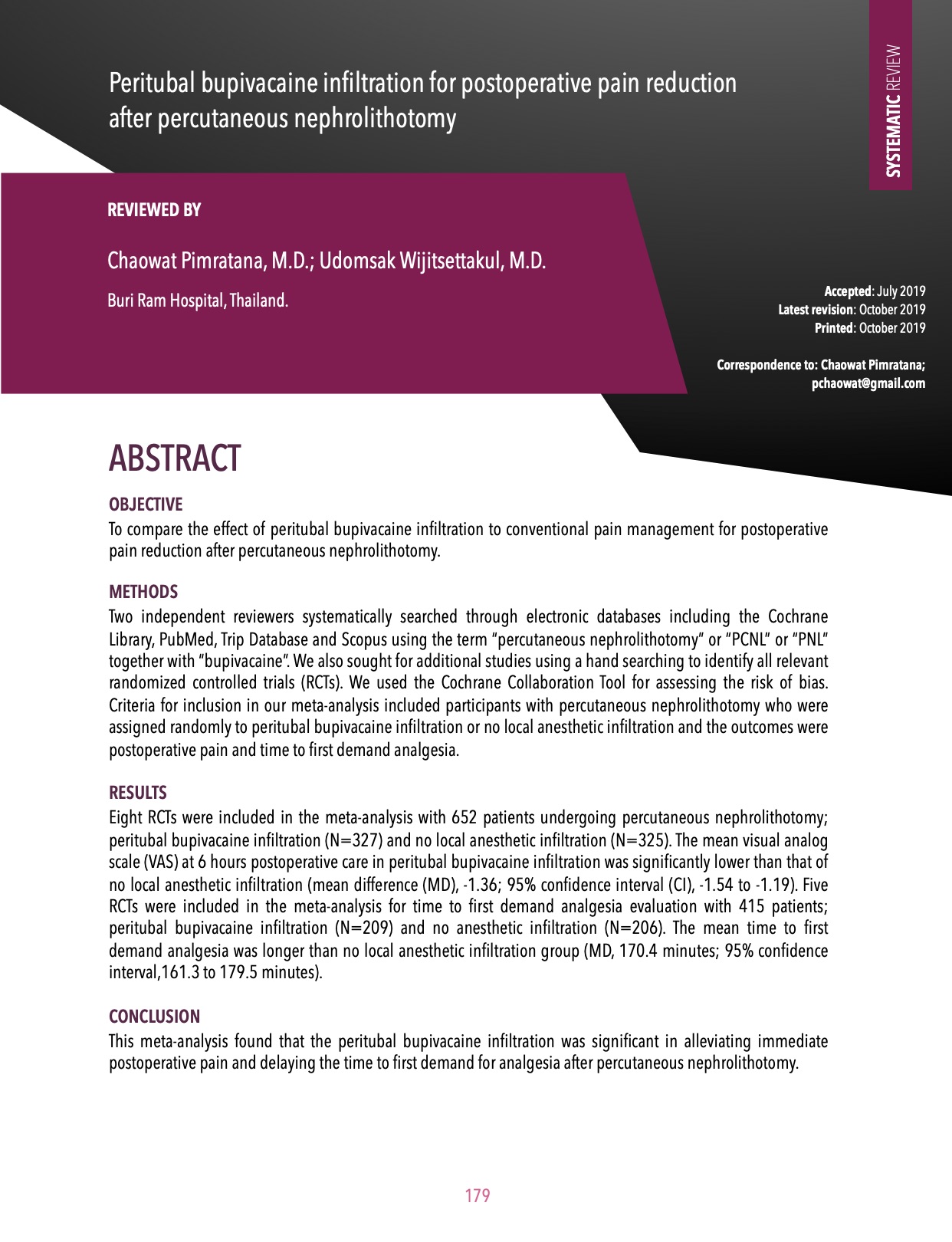Peritubal bupivacaine infiltration for postoperative pain reduction after percutaneous nephrolithotomy
Keywords:
percutaneous nephrolithotomy, peritubal infiltration, bupivacaine, postoperative painAbstract
OBJECTIVE
To compare the effect of peritubal bupivacaine infiltration to conventional pain management for postoperative pain reduction after percutaneous nephrolithotomy.
METHODS
Two independent reviewers systematically searched through electronic databases including the Cochrane Library, PubMed, Trip Database and Scopus using the term “percutaneous nephrolithotomy” or “PCNL” or “PNL” together with “bupivacaine”. We also sought for additional studies using a hand searching to identify all relevant randomized controlled trials (RCTs). We used the Cochrane Collaboration Tool for assessing the risk of bias. Criteria for inclusion in our meta-analysis included participants with percutaneous nephrolithotomy who were assigned randomly to peritubal bupivacaine infiltration or no local anesthetic infiltration and the outcomes were postoperative pain and time to first demand analgesia.
RESULTS
Eight RCTs were included in the meta-analysis with 652 patients undergoing percutaneous nephrolithotomy; peritubal bupivacaine infiltration (N=327) and no local anesthetic infiltration (N=325). The mean visual analog scale (VAS) at 6 hours postoperative care in peritubal bupivacaine infiltration was significantly lower than that of no local anesthetic infiltration (mean difference (MD), -1.36; 95% confidence interval (CI), -1.54 to -1.19). Five RCTs were included in the meta-analysis for time to first demand analgesia evaluation with 415 patients; peritubal bupivacaine infiltration (N=209) and no anesthetic infiltration (N=206). The mean time to first demand analgesia was longer than no local anesthetic infiltration group (MD, 170.4 minutes; 95% confidence interval,161.3 to 179.5 minutes).
CONCLUSION
This meta-analysis found that the peritubal bupivacaine infiltration was significant in alleviating immediate postoperative pain and delaying the time to first demand for analgesia after percutaneous nephrolithotomy.
References
Fernström I, Johansson B. Percutaneous pyelolithotomy. A new extraction technique. Scand J Urol Nephrol. 1976;10(3):257–9.
Khan SA, Khalid SE, Effendi FN, Mithani MH, Awan AS, Mugal T. Postoperative Pain Score of Bupivacaine versus Placebo in Patients Undergoing Percutaneous Nephrolithotomy. J Coll Physicians Surg--Pak JCPSP. 2018 Nov;28(11):858–61.
Jonnavithula N, Pisapati MVLN, Durga P, Krishnamurthy V, Chilumu R, Reddy B. Efficacy of peritubal local anesthetic infiltration in alleviating postoperative pain in percutaneous nephrolithotomy. J Endourol. 2009 May;23(5):857–60.
Dalela D, Goel A, Singh P, Shankhwar SN. Renal capsular block: a novel method for performing percutaneous nephrolithotomy under local anesthesia. J Endourol. 2004 Aug;18(6):544–6.
Lojanapiwat B, Chureemas T, Kittirattarakarn P. The efficacy of peritubal analgesic infiltration in postoperative pain following percutaneous nephrolithotomy - A prospective randomized controlled study. Int Braz J Urol Off J Braz Soc Urol. 2015 Oct;41(5):945–52.
Shafiei FT, Lopez J. Bupivacaine. In: StatPearls [Internet]. Treasure Island (FL): StatPearls Publishing; 2019 [cited 2019 Jun 25]. Available from: http://www.ncbi.nlm.nih.gov/books/NBK532883/
Kirac M, Tepeler A, Bozkurt OF, Elbir F, Ozluk C, Armagan A, et al. The efficacy of bupivacaine infiltration on the nephrostomy tract in tubeless and standard percutaneous nephrolithotomy: a prospective, randomized, multicenter study. Urology. 2013 Sep;82(3):526–31.
Parikh GP, Shah VR, Modi MP, Chauhan NC. The analgesic efficacy of peritubal infiltration of 0.25% bupivacaine in percutaneous nephrolithotomy - A prospective randomized study. J Anaesthesiol Clin Pharmacol. 2011 Oct;27(4):481–4.
Jadad AR, Moore RA, Carroll D, Jenkinson C, Reynolds DJ, Gavaghan DJ, et al. Assessing the quality of reports of randomized clinical trials: is blinding necessary? Control Clin Trials. 1996 Feb;17(1):1–12.
Higgins JPT, Altman DG, Gøtzsche PC, Jüni P, Moher D, Oxman AD, et al. The Cochrane Collaboration’s tool for assessing risk of bias in randomised trials. The BMJ [Internet]. 2011 Oct 18 [cited 2019 Jul 6];343. Available from: https://www.ncbi.nlm.nih.gov/pmc/articles/PMC3196245/
Myles PS, Myles DB, Galagher W, Boyd D, Chew C, MacDonald N, et al. Measuring acute postoperative pain using the visual analog scale: the minimal clinically important difference and patient acceptable symptom state. Br J Anaesth. 2017 Mar 1;118(3):424–9.
Myles PS, Weitkamp B, Jones K, Melick J, Hensen S. Validity and reliability of a postoperative quality of recovery score: the QoR-40. Br J Anaesth. 2000 Jan;84(1):11–5.
Mankongsrisuk T, Nualyong C, Tantiwong A, Taweemonkongsap T, Amornvesukit T, Chotikawanich E. Efficacy of Nephrostomy Tract Infiltration with Bupivacaine Before and After Tubeless Percutaneous Nephrolithotomy: A Randomized Control Study. 2017;100:6.
Haleblian GE, Sur RL, Albala DM, Preminger GM. Subcutaneous bupivacaine infiltration and postoperative pain perception after percutaneous nephrolithotomy. J Urol. 2007 Sep;178(3 Pt 1):925–8.
Karaduman I, Karasu D, Yilmaz C, Oner S, Erdem Solak H, Korfali G. The Effect of Peritubal Infiltration with Bupivacaine and Morphine on Postoperative Analgesia in Patients Undergoing Percutaneous Nephrolithotomy. Pain Res Manag. 2017;2017:2454267.



